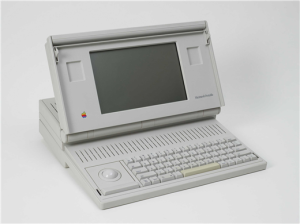Archive for August 2024
Street Fighter II Turbo: Hyper Fighting for SNES
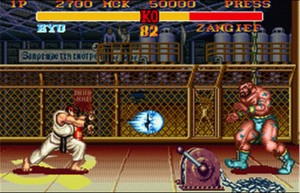 August 13, 1993
August 13, 1993
Capcom releases Street Fighter II Turbo: Hyper Fighting for the Super NES in the US. The Street Fighter II arcade game started the fighting game boom of the 1990’s, which spawned off other many other fighting game franchises such as Mortal Kombat and Virtua Fighter. The Super NES version brought Street Fighter II into the home and … um … college dorms where certain people spent many hours smacking down their dorm mates.
I still have this game so if anyone is feeling saucy, the smack downs can resume at any time.
The IBM PC Introduced
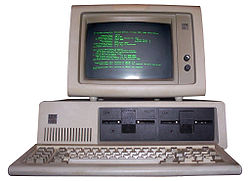 August 12, 1981
August 12, 1981
IBM introduces its first personal computer, the IBM PC Model 5150. IBM originally intended this model to be a stop-gap computer that would allow them to quickly tap into the emerging personal computer market while taking the time to develop a “real” PC. It was developed in under a year by a team of 12 with the goal of rapid release to market. Therefore, this team was allowed to work outside of the normal IBM development process and use whatever “off-the-shelf” components allowed for the quickest development. This overriding goal of developing something as quickly as possible had monumental unintended consequences for IBM and the computer industry as a whole that are still being felt to this day.
By compromising quality for rapidity, the design of the IBM PC forced software programmers to resort to inelegant methods of software development, hindering the reliability and compatibility of their software. This laid the groundwork for the reputation of the PC as error-prone and frustrating to use. The use of common components and the choice of Microsoft’s DOS as the PC’s operating system allowed other companies to quickly clone the IBM PC. They also allowed Microsoft to license their DOS to other companies, giving Microsoft control of the operating system market. Ultimately these choices lead to IBM’s loss of control of the platform. IBM never did really get a chance to create their “real” PC. And because IBM was the 800-pound gorilla of the business world at the time, the computer that was supposed to be a stop-gap became the overwhelming computing standard, crushing nearly every other emerging platform in the process.
Steve Jobs was quoted in a 1985 interview, “If … IBM wins, my personal feeling is that we are going to enter sort of a computer Dark Ages for about 20 years.” While IBM themselves didn’t win, the creation that they lost control of was the clear market winner for approximately the next 20 years. Many will argue that time was in fact a Dark Age for the home computer, but no one could have predicted that on this day in 1981.
First Communication Satellite Launched
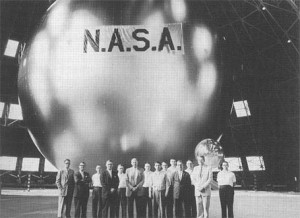 August 12, 1960
August 12, 1960
Echo 1, the world’s first communication satellite is launched. Technically, Echo 1 was a passive reflector, as communication signals were bounced off it rather than retransmitted as modern satellites do today.
Windows Gets Blasted
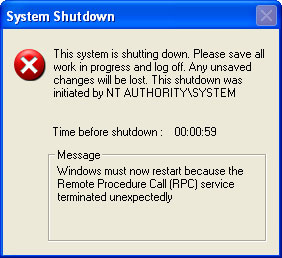 August 11, 2003
August 11, 2003
The Blaster worm, also known as MSBlast or Lovesan, begins to spread on the Internet, infecting Windows XP and Windows 2000 computers. The primary symptom of the worm was the crashing of the RPC service, which would trigger the computer to shut itself down and reboot as shown in the graphic. Microsoft estimated the number of machines infected between 8 and 16 million. Damage caused by the worm was estimated at $320 million.
First Lunar Orbiter Launched
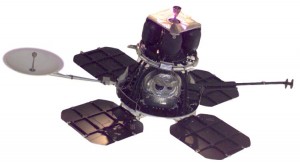 August 10, 1966
August 10, 1966
The first lunar orbiter, creatively named Lunar Orbiter I, is launched. Its primary mission is to photograph potential landing sites for future Apollo missions.
The First E-mail From Space
Astronauts aboard the Space Shuttle Atlantis, mission STS-43, use an Apple Macintosh Portable computer to send what is considered the first e-mail from space. Using the AppleLink online service, Atlantis astronauts Shannon Lucid and James C. Adamson sent the following message:
Hello Earth! Greetings from the STS-43 Crew. This is the first AppleLink from space. Having a GREAT time, wish you were here,…send cryo and RCS! Hasta la vista, baby,…we’ll be back!
The AppleLink software on the Macintosh was specially configured to connect to NASA’s communication system which allowed the Shuttle to interface with Apple’s proprietary network from space. The Macintosh Portable itself only had very minor modifications to operate in space.
Diesel Engine Patented in US
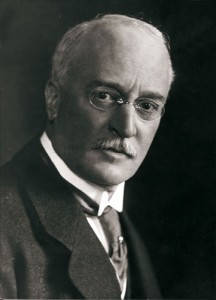 August 9, 1898
August 9, 1898
The US Patent Office awards patent 608,845 to Rudolf Diesel for his diesel internal combustion engine.
Project Chess Gets Approval
 August 8, 1980
August 8, 1980
The Project Chess team at IBM shows a prototype microcomputer to their corporate management. Management gives approval for the team to build an operational computer within a one year deadline to compete in the rapidly emerging personal computer market. One year and 4 days later, the IBM PC is introduced to the world and the rest is history.
IBM Presents Harvard the Mark I
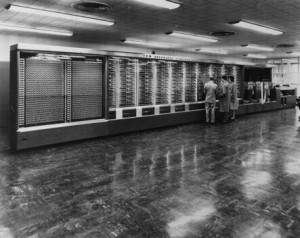 August 7, 1944
August 7, 1944
IBM presents Harvard University their Automatic Sequence Controlled Calculator (ASCC), an electro-mechanical computer devised by Howard H. Aiken and built by IBM. Harvard renamed the ASCC the Harvard Mark I. The Mark I was not significant for technological advances, as the fully-electronic ENIAC was being constructed when the Mark I was being put into service. However, the Mark I was the first large-scale digital calculator ever built and served to spark the desire for more and better computing machines.
Apple and Microsoft Call Truce
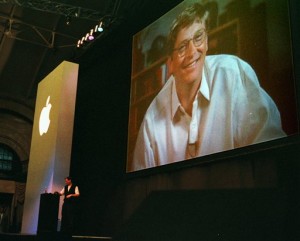 August 6, 1997
August 6, 1997
At the Macworld Expo in Boston, Steve Jobs announces that Apple and Microsoft have signed a five-year alliance. Bill Gates famously makes his seemingly ominous “big brother” appearance on the large presentation screen during the announcement. As part of the deal, Microsoft committed to continuing development of Microsoft Office for Mac over the next five years, Apple would make Internet Explorer the default web browser on the Mac, Apple and Microsoft would collaborate on Java compatibility, and Microsoft invested $150 million in Apple stock. However, the most important part of the arrangement is that both companies would cross-license all existing patents along with any new patents over the next five years, Apple would drop their long-running series of patent-infringement lawsuits against Microsoft, and Microsoft paid an undisclosed amount of money to Apple.
The common assumption in the tech community was that Microsoft’s $150 million investment in Apple saved the company. However, the reality is that with Apple holding $1.2 billion in cash at the time, $150 million was a relatively small sum of money. Some now believe the undisclosed amount of money that Microsoft paid Apple was in fact a secret settlement to the patent-infringment claims, a large part of which was related to Apple’s claim that Intel and Microsoft stole code related to the QuickTime multimedia technology. Estimated at anywhere between $500 million to $2 billion, this was the real meat of the so-called “cross-licensing” arrangement. It was likely this much larger undisclosed amount, plus the approximately $1 billion Apple earned by divesting itself of most of their investment in ARM stock over the course of 1998-1999, along with the show of confidence that Apple would be around at least another five years that gave Apple and Steve Jobs the breathing room needed to reinvent Apple and eventually build it into the most valuable company in the world.

